Australia have appeared at every FIFA Women’s World Cup since 1995 but in each edition of the tournament, they have failed to make it further than the quarter-final stage. This is something they will be looking to remedy in front of their home crowd this summer.
Tony Gustavsson has been in his post as head coach since 2020. For the most part, the 49-year-old has received praise for the style of play he’s implemented with The Matildas. The team has recorded some impressive victories lately, including a 3-2 victory over Spain and a 2-0 win over European Champions, England. It hasn’t all been plain sailing though; Australia struggled in the 2022 AFC Women’s Asia Cup, getting knocked out in the quarter-finals after a loss to South Korea.
This tactical analysis and team-focused scout report will delve into the tactics that Australia will most likely use during the World Cup. We will provide an in-depth analysis of how the Matildas perform in attack, defence and transition phases as well as look at the players who will perform key roles for Gustavsson.
Predicted Starting XI
During Gustavsson’s tenure, The Matildas have mostly lined up in a 4-2-3-1 and more recently a 4-4-2 formation. For the upcoming World Cup, the latter formation is probably the one Gustavsson will opt to use, as throughout most of the recent friendlies, he has set up in a 4-4-2.
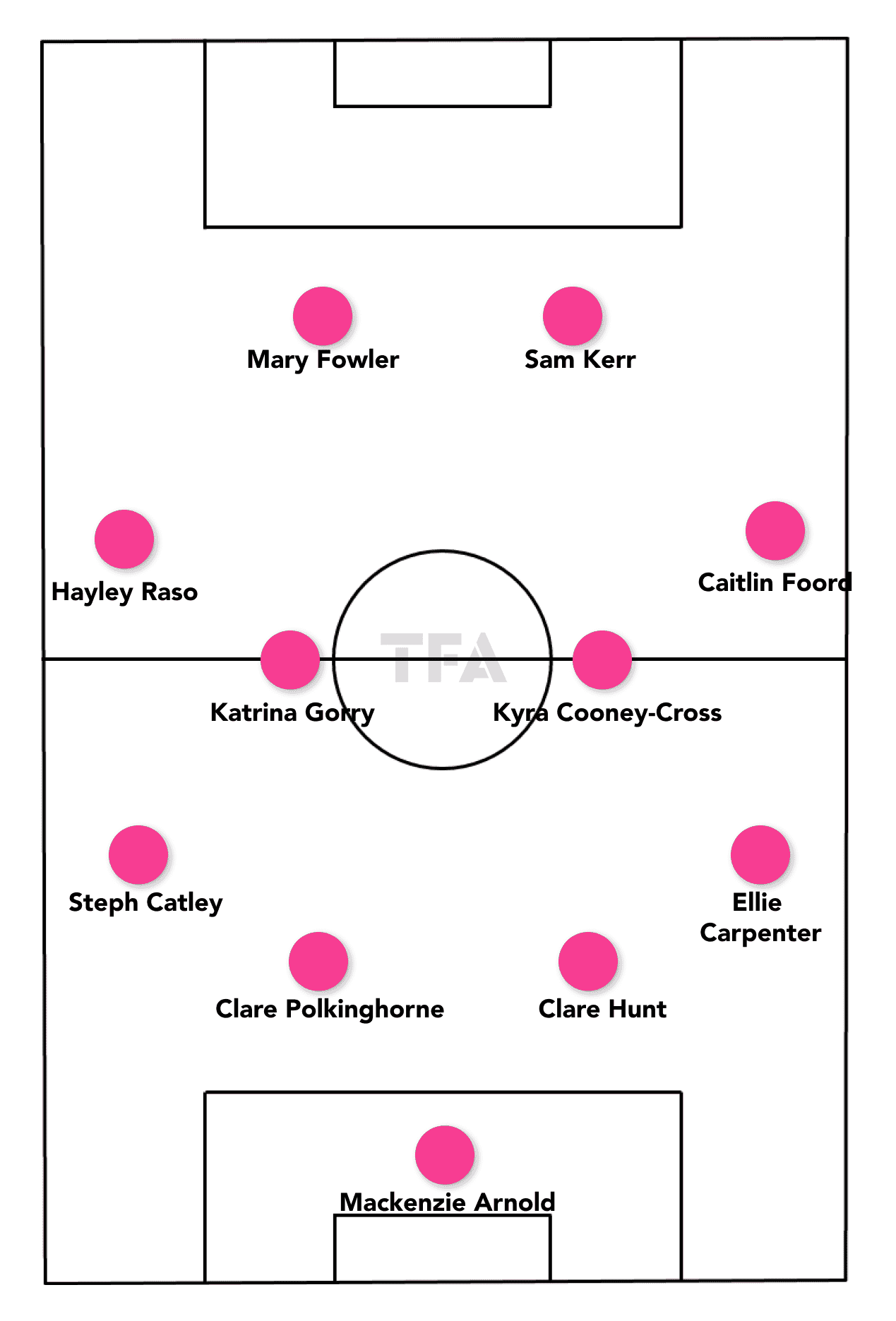
Mackenzie Arnold will likely be the starting goalkeeper, with Ellie Carpenter being the starter at right-back. A centre-back pairing of the vastly experienced Clare Polkinghorne and Clare Hunt will provide the Matildas with an excellent foundation alongside Arsenal fan favourite Steph Catley at left-back.
In the midfield, Gustavsson likes plenty of speed on the wings so Hayley Raso is often deployed on the left. As for the right side, whilst Cortnee Vine has impressed in recent games and would offer a wonderful outlet on the right wing, it is more likely that Gustavsson will opt for the experience of Caitlin Foord — at least for the first few games. The central midfielders in the starting XI are most likely to be Katrina Gorry and Kyra Cooney-Cross as they have developed a very good partnership recently and will play an important role in Gustavsson’s style of play.
Of course, captain Sam Kerr will be the first name on the team sheet; the ever-reliable forward will play in a front two, probably alongside 20-year-old Mary Fowler who has established herself at international level over the last couple of years.
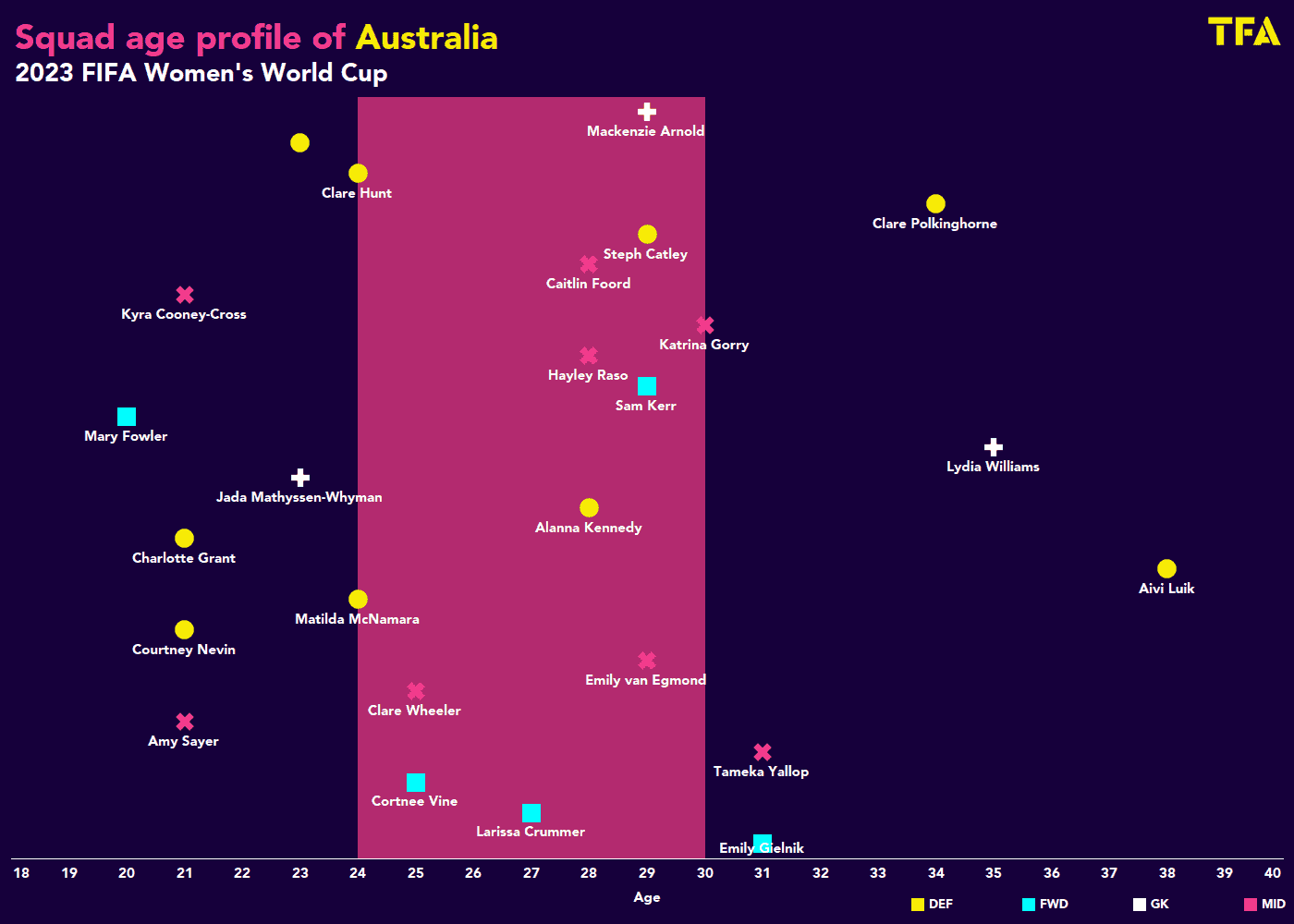
As we can see from the data visual above, Australia have a wide-ranging squad in terms of age, something which could prove very useful throughout this tournament. The vastly experienced players such as Polkinghorne, Lydia Williams and Tameka Yallop will be able to utilise all their knowledge to guide the younger players such as Amy Sayer, Mary Fowler and Courtney Nevin.
Equally, we can see that many of their players fall in the 24-30 age bracket, which means they are likely to be in their footballing prime and are experienced enough at international level to cope with the inevitable pressure and lofty expectations for the hosts.
Attacking Phase
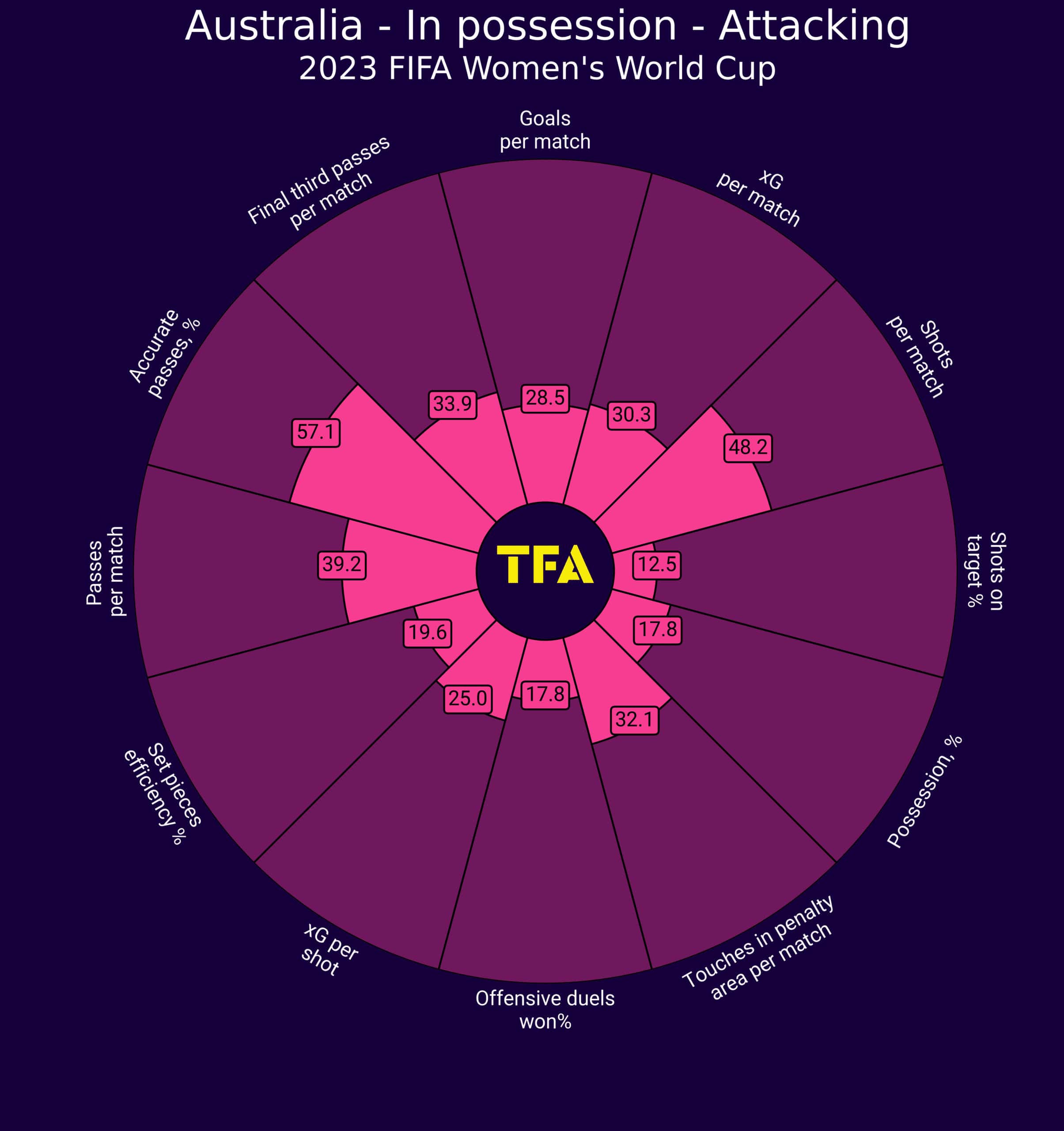
The data visual above shows how Australia perform in the attacking phase of play, we can see that they are very much a team that is happy to play without possession and hit teams on the counterattack. They are able to carve out a good amount of scoring opportunities from playing this way, as we can see from the number of shots per match. However, few of these are on target so perhaps they will need to be more clinical than usual during the World Cup if they are to progress.
Australia’s build-up play in the attacking phase largely depends on the type of opponent they are facing. They are blessed with an abundance of pace in their attacking options, which is something they continuously look to exploit at any given opportunity.
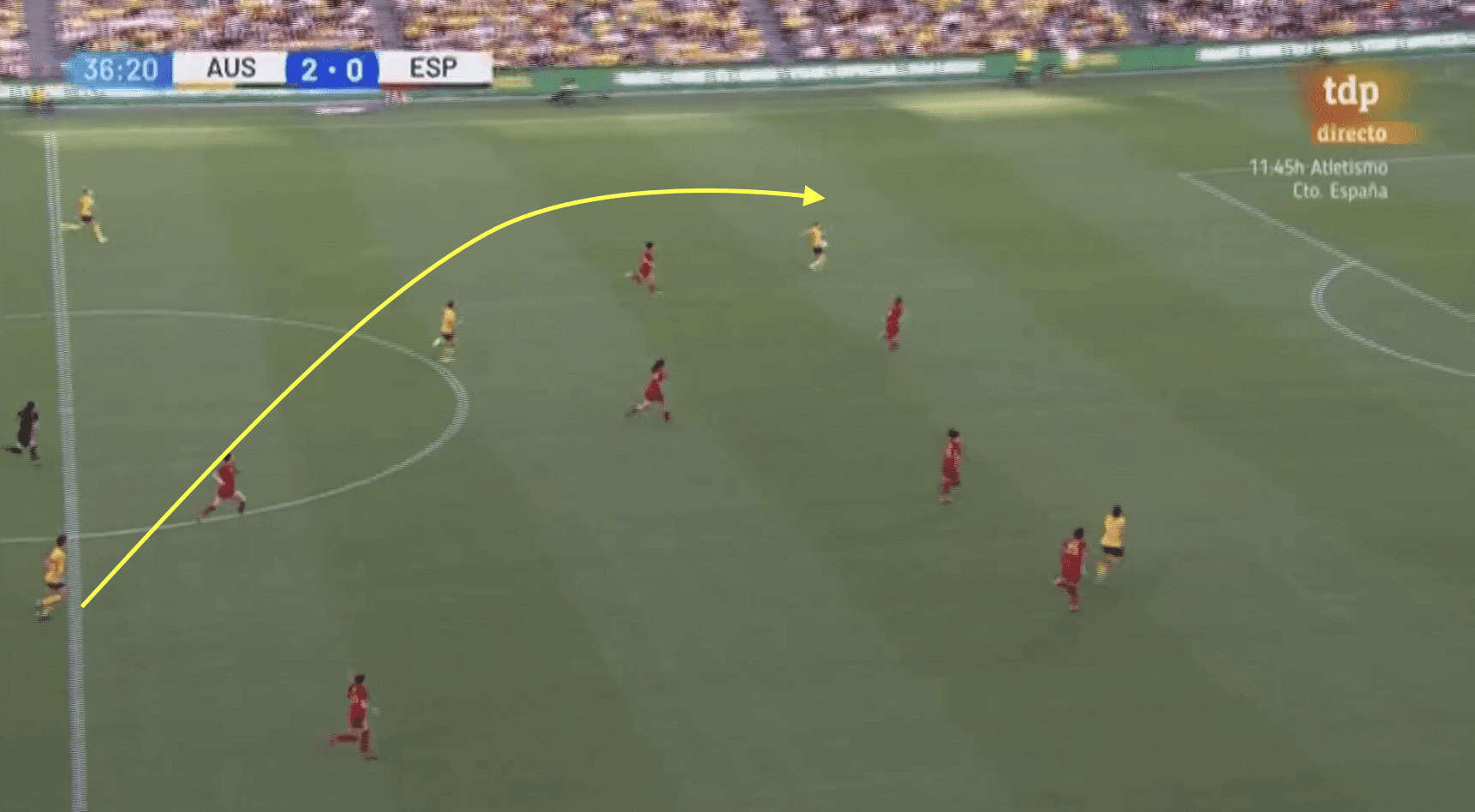
When playing against a team that dominates possession and presses relatively high, Australia will look to play long passes, usually from midfield, over the top to the forwards. This provides a direct and quick attacking option, enabling them to bypass the midfield area so the forwards can use their speed to beat the defenders in a foot race and receive the ball in a dangerous position, giving them a better chance of scoring.
As shown in the image above, we can see that the Matildas have looked to take advantage of Spain’s press and have played a ball over the top into the path of Caitlin Foord.
By playing a long pass over the top, the Spanish defenders are forced to retreat and cover more ground to defend against the Australian forwards. This creates gaps and spaces in the defence, which can be exploited by Sam Kerr and Caitlin Foord in this case.
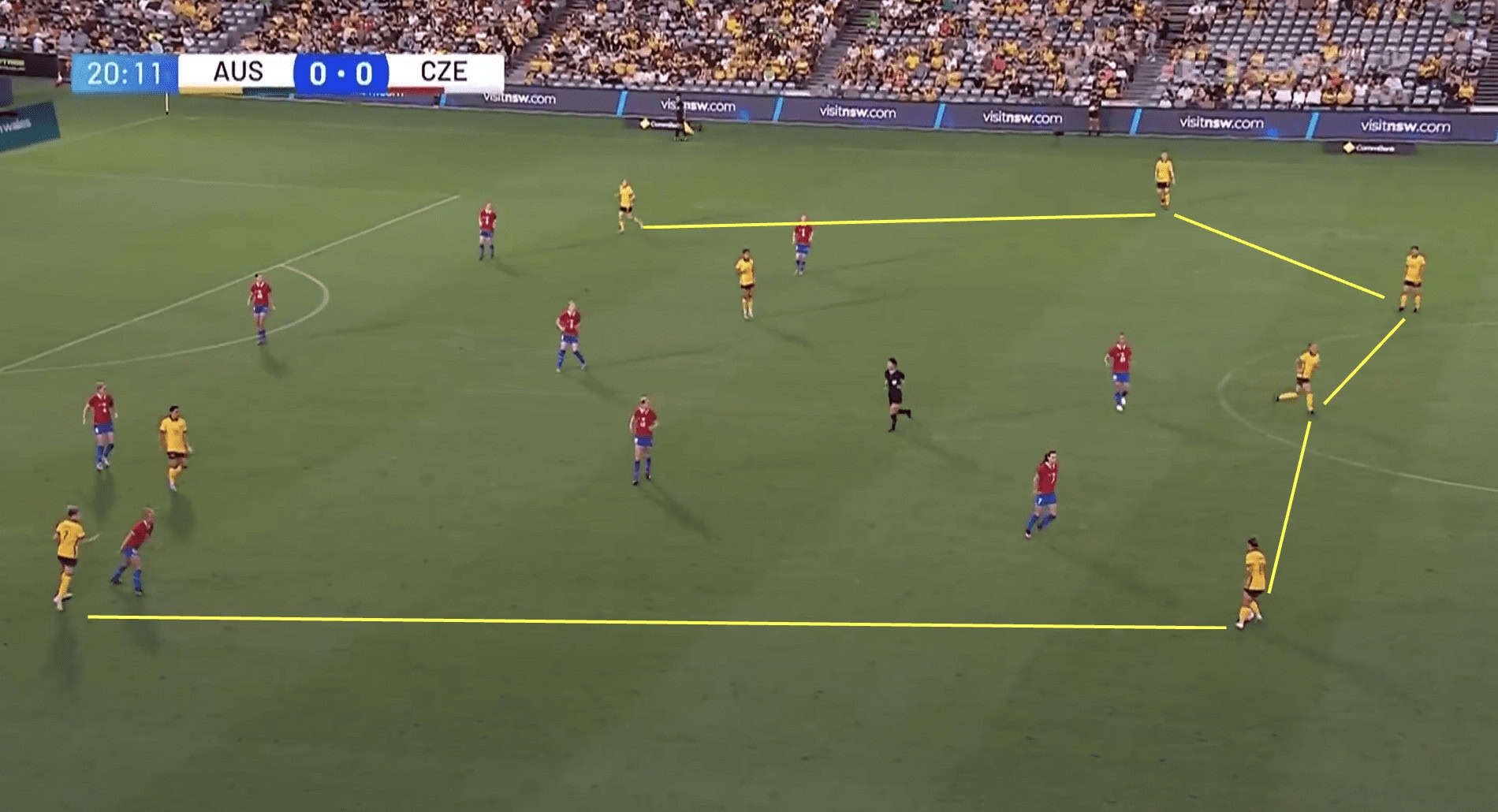
When playing against a team that will mostly look to sit back and counterattack, Australia will seek to pin their opponents back into the defensive half as shown above in the game against the Czech Republic. We can see that eight players have pinned the Czech team back into their own half, allowing Australia the opportunity to build an attack at their own pace and ensuring they are able to retain the ball.
Restricting the opposition to their own half limits their ability to launch quick counterattacks. This is accomplished by maintaining pressure and preventing the opposition from transitioning smoothly from defence to attack. When the opposition is pinned back, they have fewer opportunities to exploit spaces left open, reducing the threat of counterattacks and giving Australia more control over the game.
Moreover, when the opposition are pushed deep into their own half, Australia have more space and time to build their attacks. The Matildas’ attacking players can receive the ball in advanced positions, closer to the opposition’s goal, which increases the likelihood of creating goalscoring opportunities. Additionally, pinning the opposition back can lead to more set-piece situations, such as corners or free kicks, which offer additional chances to score.
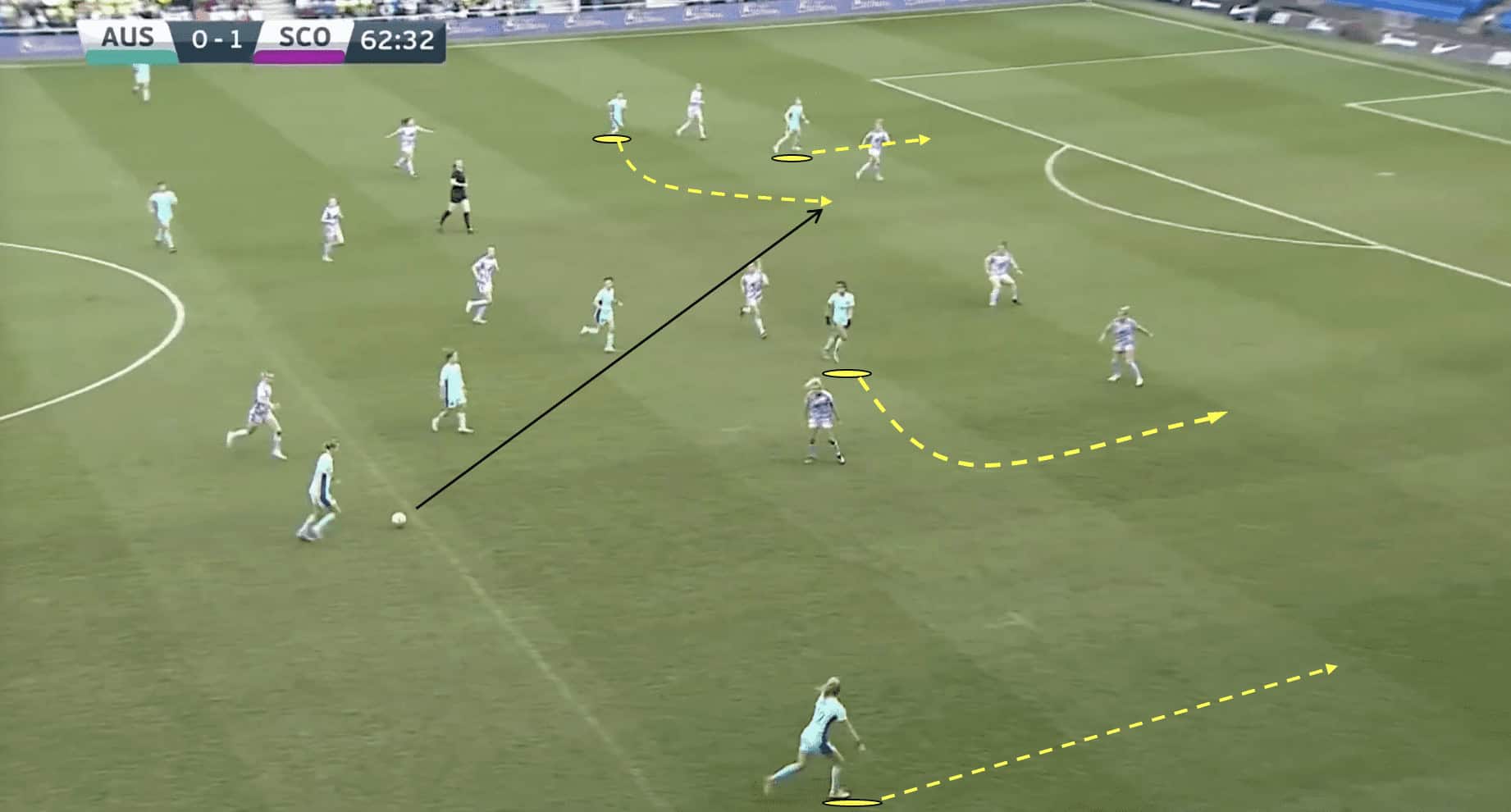
Additionally, the Australian players will use smart off-the-ball movements in order to create space during the attacking phase. As shown in the image above, right-back Ellie Carpenter will maraud forward down the right wing in order to draw one or two opposition players out wide.
In the scenario shown above, Gustavsson sent his team out in a 4-4-2 formation, Mary Fowler has dropped a little deeper in a bid to drag one of the Scotland central defenders with her. The other centre-forward, Larissa Crummer, makes a run in between the Scotland right-back and right-sided central defender which then creates space for Hayley Raso to make a run into a more central area and receive the pass.
The one common theme that runs throughout Australia’s play in the attacking phase is their desire to create space for wide players such as Raso and Vine to make inverted runs into more central areas. Of course, Gustavsson has many talented players to rely on, especially Sam Kerr who is incredibly clinical in front of goal and whose goalscoring abilities will most likely decide games for Australia at the World Cup.
Defensive Phase
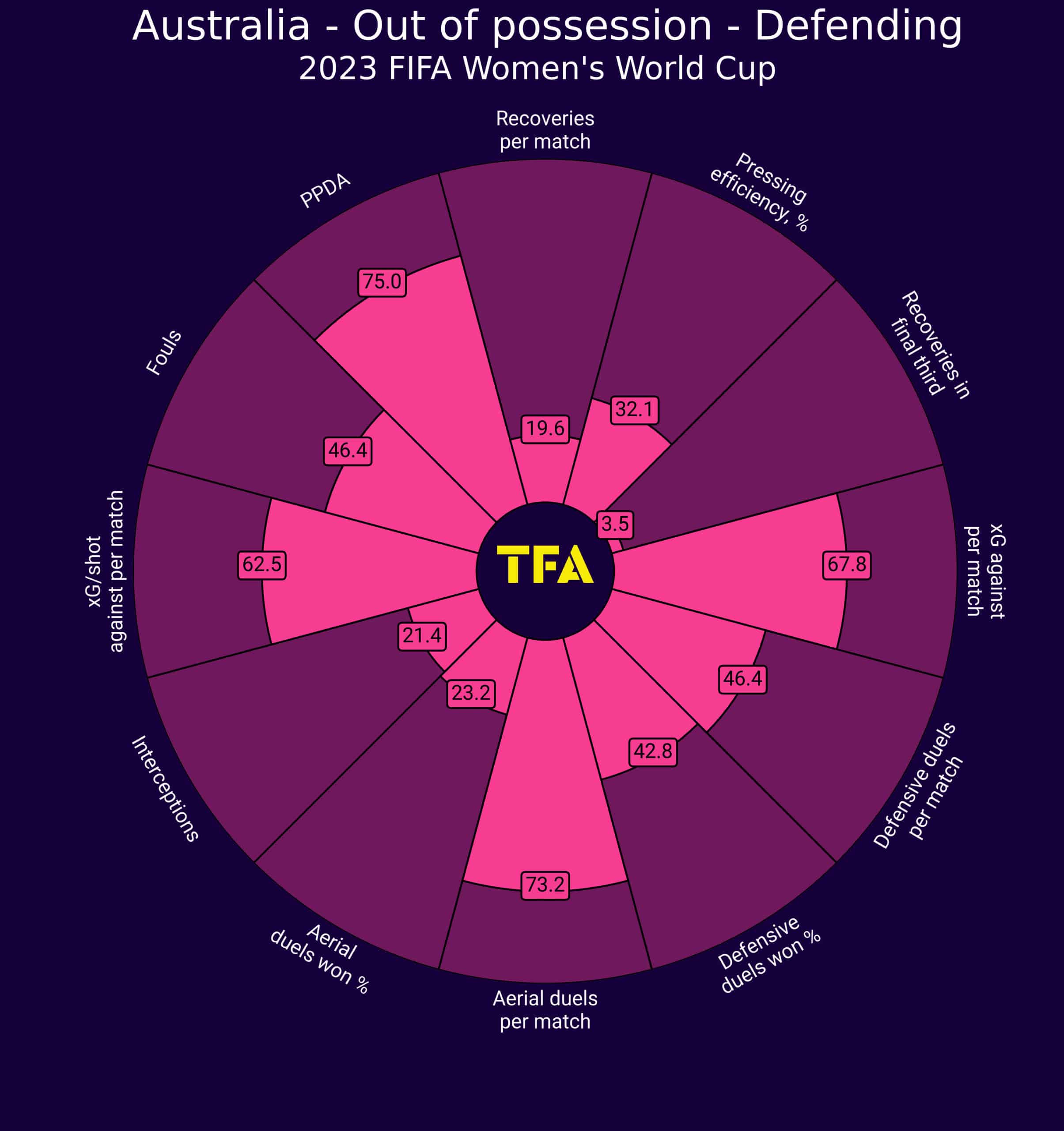
In this data visual above, we can see how Australia perform in the defensive phase of play. Evidently, they are not a team that likes to press high. It’s also true that Australia do concede a reasonable amount of expected goals per 90, meaning that teams will be able to create goalscoring opportunities against them. Therefore, it largely depends on how clinical the opposition is whether this results in Australia conceding goals. As we have already ascertained in this tactical analysis, Australia are very much a counterattacking team.
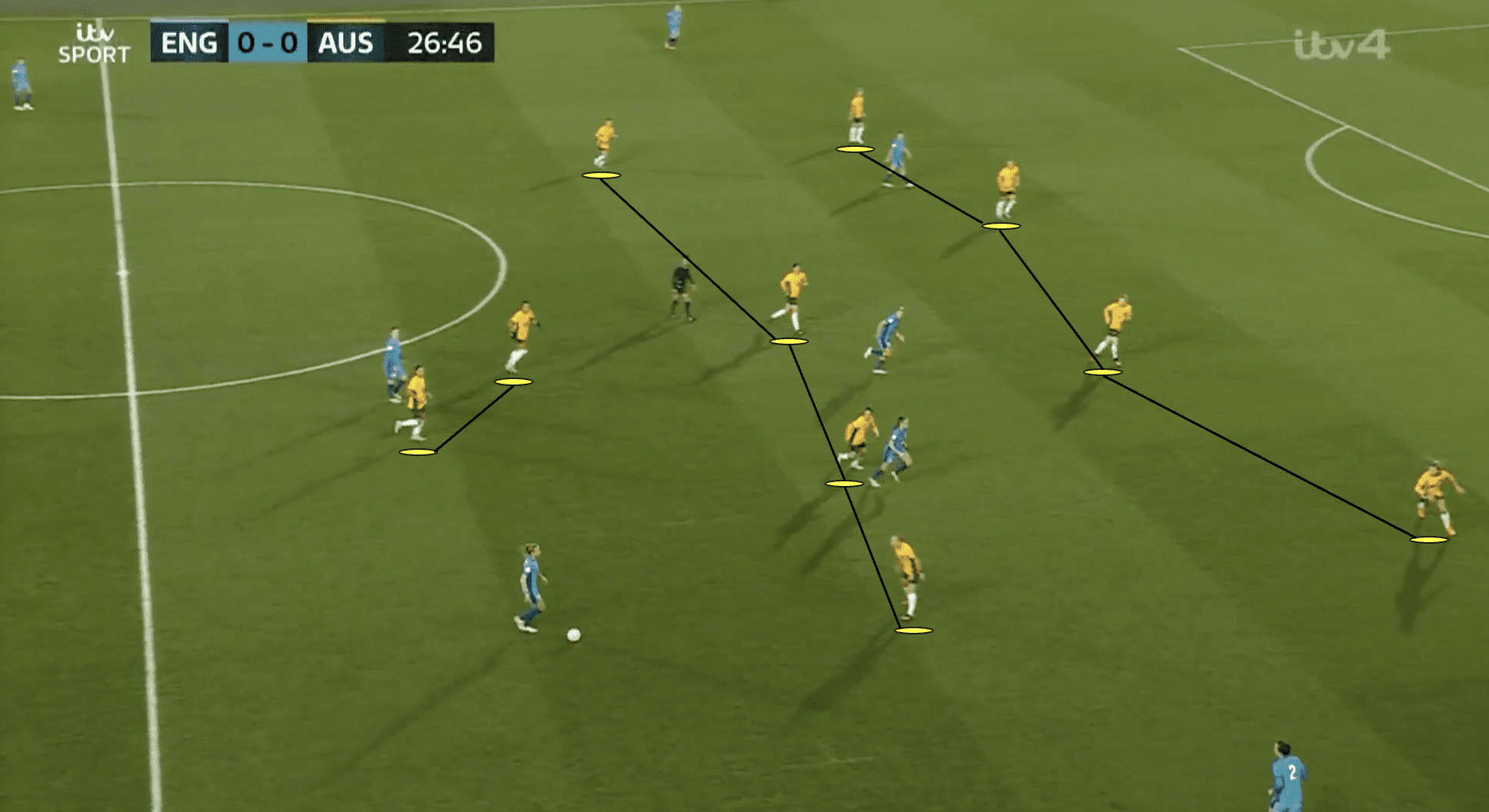
Regardless of what formation Gustavsson deploys, Australia will primarily look to adopt a compact 4-4-2 shape in the defensive phase, as we can see above. With a bank of four defenders and another bank of four midfielders, the team can effectively close down spaces and restrict the opposition’s attacking options. The compact shape ensures that there are fewer gaps between the lines, making it difficult for the opposing team to exploit spaces and penetrate the defence which is the case with England, as shown in the image above.
The compact shape means Australia have a good chance of winning back possession quickly and preventing the opposition from building their attacks through the centre of the pitch. Additionally, the two strikers can press and engage the opposing defenders, creating additional pressure and making it harder for them to distribute the ball effectively.

When playing against a team that uses an attacking midfielder or a number ‘10’ in the attacking phase, as England do, Gustavsson seeks to limit their creative abilities in-game.
In the scenario shown above, Ella Toone is acting as the ‘10’ for England and one of the Australian midfielders has been tasked with essentially marking her out of the game. By cutting off the passing lane to Toone, she cannot link the play between the midfield and the forward line which, of course, limits the ability to carve out goalscoring chances.
In order to compensate for the fact that one of the midfielders has dropped off in order to mark Ella Toone, striker Mary Fowler will drop back into the midfield for Australia. This ensures the opposition passing lanes are closed off and that the Matildas can initiate a press should they choose to.
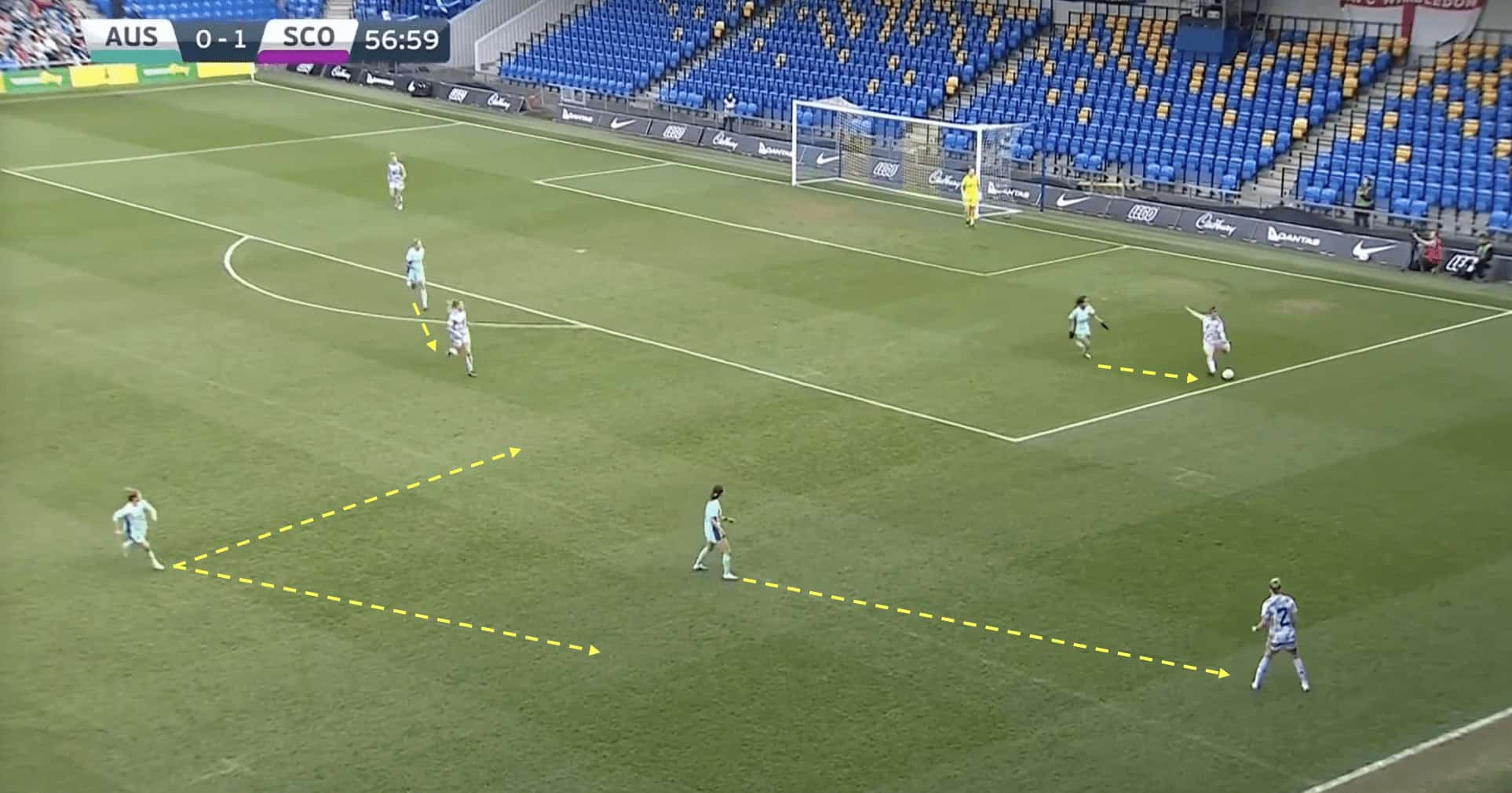
With a PPDA of 13.15 from the last 12 months, it’s fair to say that Australia do not endeavour to press high throughout games. However, at various points throughout, they will seek to press their opponents as they build an attack.
They primarily do this to disrupt the play as the high press reduces the time and space available to the opposition players, forcing them to make quick decisions under pressure. This can lead to rushed passes and turnovers in possession. As shown above, Australia aims to close down passing lanes and cut off options, forcing the opposition into making mistakes or resorting to long balls which means Australia are more likely to recover possession.
Transitions
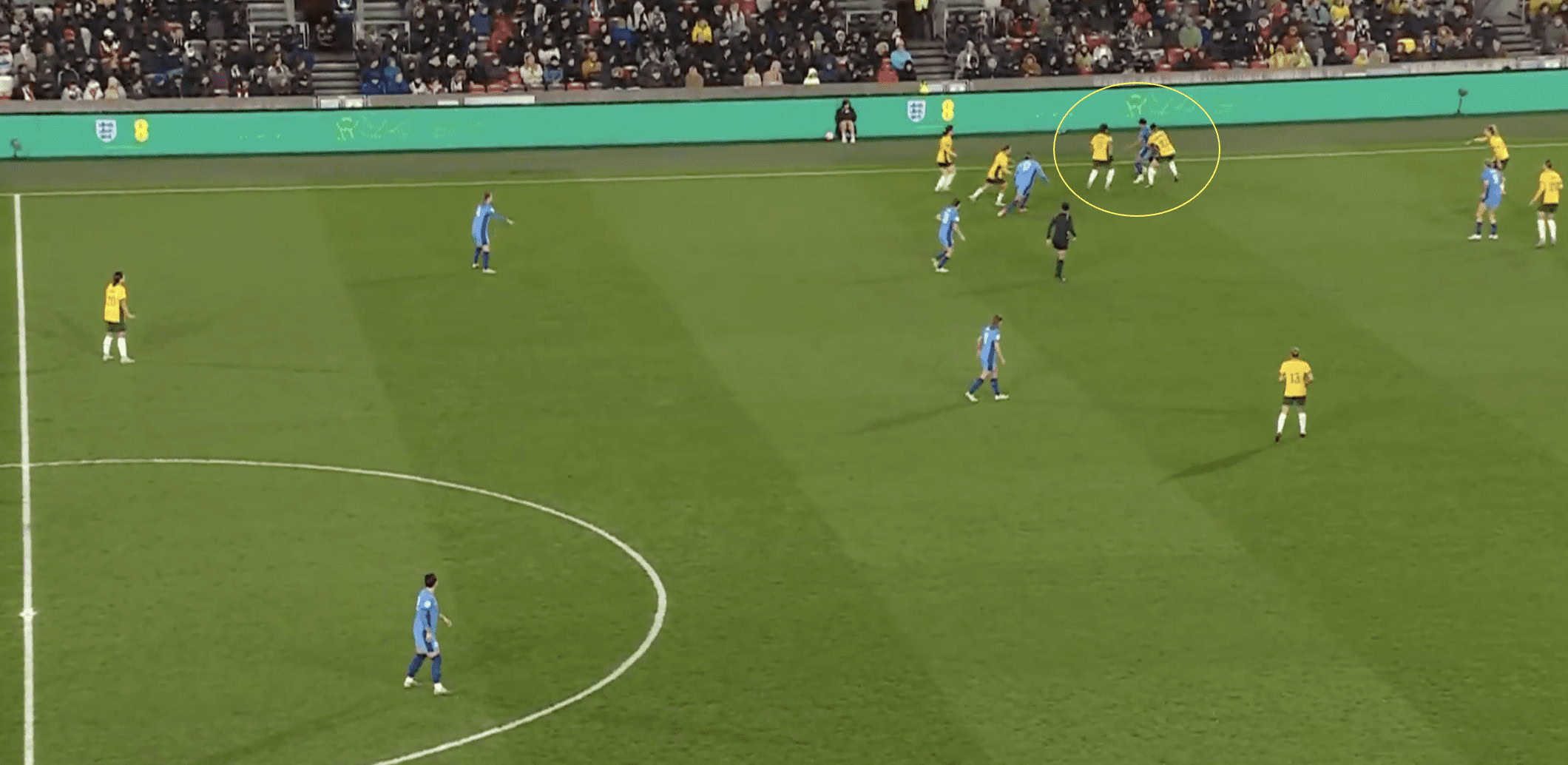
In this section of the tactical analysis, we will focus on how Australia transition from attack to defence. Upon losing possession, especially when in their own half, Australia will engage in a fairly rapid counterpress as we can see above, in order to prevent their opponent from launching a counterattack of their own.
We can see in the image above that the Matildas lost possession and within seconds, there were two players in Australia shirts counterpressing and looking to win back possession. This means that England cannot build an attack and ensures that Australia will have the opportunity of a counterattack of their own should they regain possession.
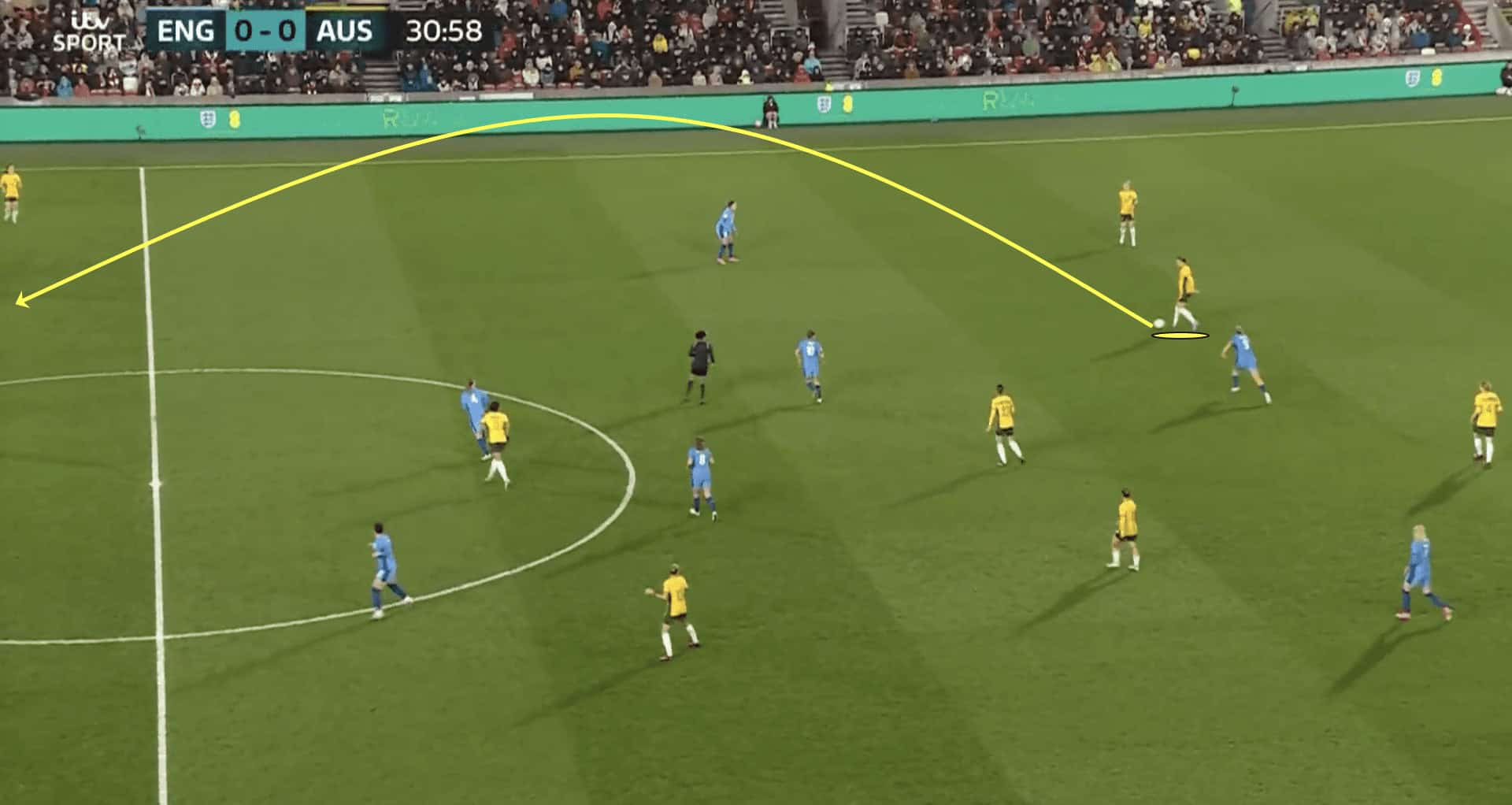
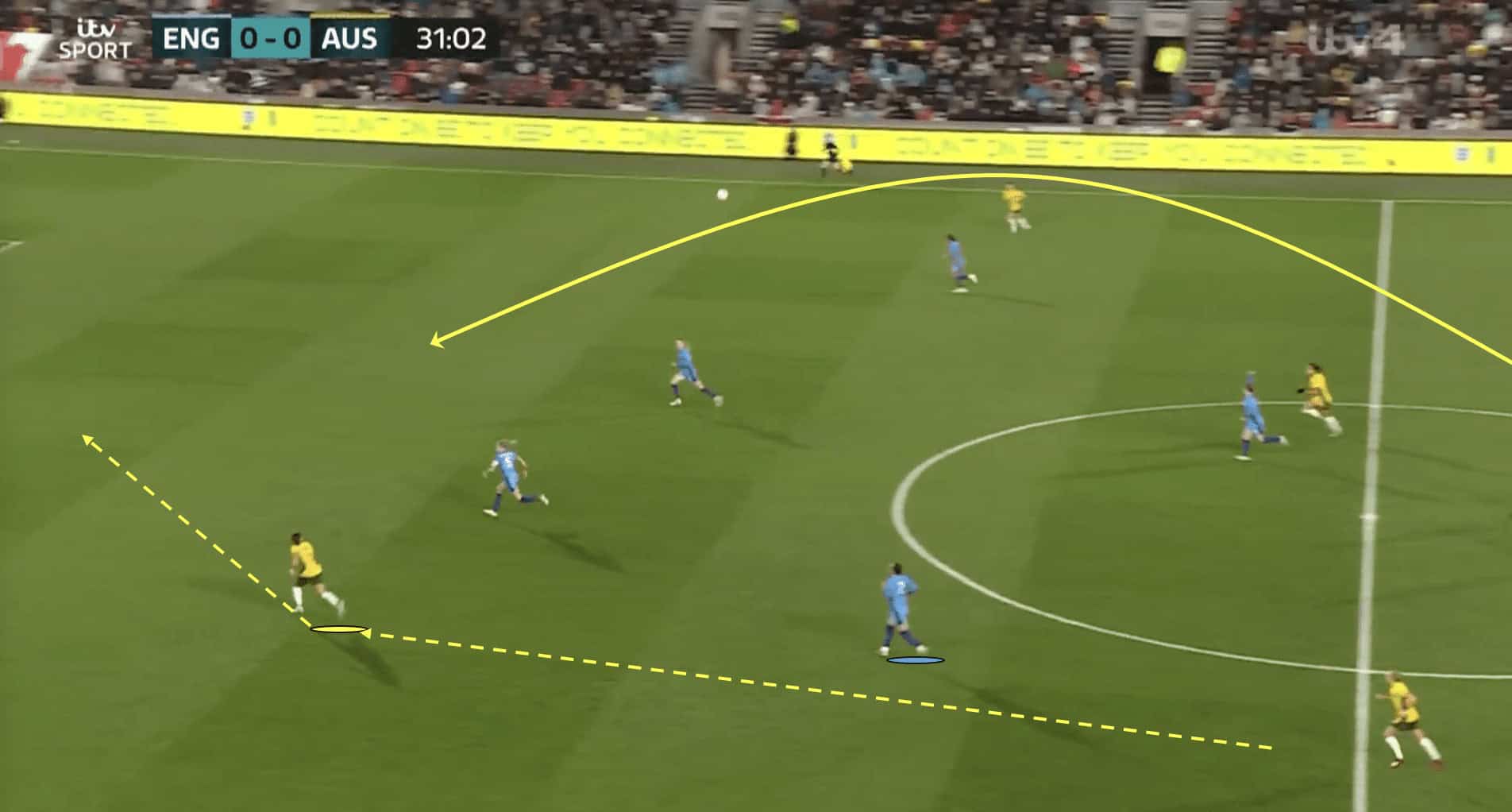
Now, looking at Australia as they transition from defence to attack, the first option they look to exploit is the long pass over the top to Sam Kerr. As we can see in the images above, England have lost possession and Australia immediately play a pass over the top of the defence as they are tracking back.
Sam Kerr possesses a good amount of pace which allows her to travel up the pitch quickly, in this specific scenario, she was able to exploit the space that had been left due to Lucy Bronze’s penchant for pushing up incredibly high. This ultra-quick transition resulted in a goal for Australia as England were all at sea and the ball reached Kerr, albeit due to a mistake from England’s central defenders.
It is this particular transition that makes Gustavsson’s team such a threat and why teams that like to hold a high defensive line during the attacking phase, such as England, must always be aware that with one pass over the top Australia can be lethal.
Playing a long ball quickly transitions Australia from a defensive to an attacking position. By launching the ball forward into the opponent’s half, they bypass the midfield and defensive lines, catching the opposition off guard. This sudden change in momentum can lead to a quick counterattack, exploiting the spaces left by the retreating defenders and creating scoring opportunities.
Secondly, a long ball can be effective in capitalising on the element of surprise. When the opposition expects the team to build up play slowly from the back, a sudden long ball can catch them off balance. Defenders may not be adequately positioned or prepared to deal with a long pass, allowing attackers to gain a significant advantage in terms of positioning and time on the ball.
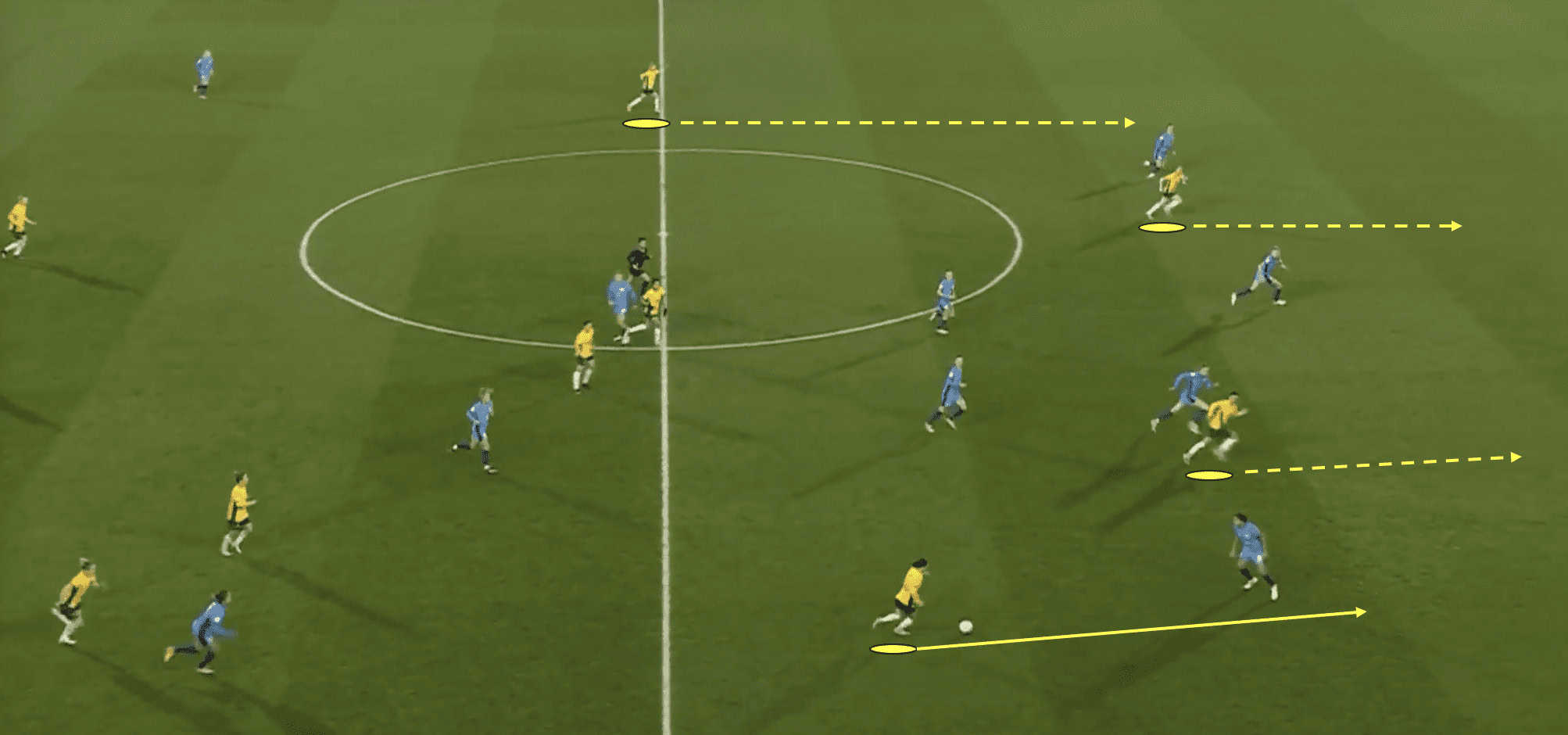
Alternatively, when Australia regain possession closer to the opposition half, they prioritise getting runners in behind the defensive line as it attempts to track back. As we can see in the image here, Hayley Raso is in possession and there are three Australia players looking to make a run into the attacking third as England attempt to get back in their defensive shape.
When runners penetrate behind the defensive line, they force defenders to turn and face their own goal, as shown above. This action creates gaps and disorganisation in the defence, as defenders scramble to adjust their positions and mark the runners. These gaps can be exploited by other attacking players who can receive passes or make runs into these newly created spaces, providing more options for the attacking team to penetrate and create scoring opportunities.
The transition phase from defence to attack is where Australia pose the biggest threat, the speed of players such as Vine, Raso and Kerr mean that they are able to make those runs in behind the opposition defence.
Attackers
Of course, the prolific Sam Kerr is most likely to wear the captain’s armband for The Matildas. The Chelsea forward has scored 26 goals this season and will be heading into the World Cup off the back of winning the domestic double at club level. Mary Fowler has struggled for game time at Manchester City this season but her pace, work ethic and eye for goal mean she is always a threat, especially when Australia are looking to counterattack. Versatile Arsenal forward Caitlin Foord brings a wonderful skillset to the table, especially as she can also play on the left flank which could prove very useful.
Midfielders
In terms of the wide areas, Hayley Raso and Cortnee Vine have impressed in recent friendlies and will be able to provide an excellent amount of speed down the flanks, additionally, Tameka Yallop can cover out wide if required. Katrina Gorry is a hard-working central midfielder who is incredibly reliable and will provide a wealth of experience alongside Kyra Cooney-Cross.
Emily van Egmond is another very accomplished player who could prove to be crucial from the bench as Australia look to hold onto leads. Gustavsson will not be able to call upon set piece specialist Elise Kellond-Knight though, as she will miss the World Cup due to an injury she sustained earlier in the season.
Defenders
Defensively, Australia have the likes of Alanna Kennedy and Steph Catley who both have over 100 caps to their name, however, both players have struggled with injuries this season and are still working their way back to fitness so there is a question mark over whether either of them will be a starter for Gustavsson.
Ellie Carpenter has done well to come back from her ACL injury and reclaim her place as the starting right back and 34-year-old Clare Polkinghorne will be playing in what could be her final World Cup after an international career that has spanned over a decade.
Key Player
We can’t talk about Australia without mentioning Sam Kerr, the talismanic forward will undoubtedly be the key play for Gustavsson as he seeks to guide this team to World Cup success.

We can see from the visual above how Sam Kerr compares to fellow strikers in the WSL. The Chelsea forward scored 26 goals in all competitions this season and chipped in with five assists for Emma Hayes’ team. Kerr is well known for her aerial ability and as we can see from the data visual she has an incredibly high win percentage in terms of aerial duels.
As we know, Kerr is lethal in front of goal but she is also very skilled at linking up the play and bringing others into the game which will be beneficial as she will likely be playing in a front two. Additionally, with Sam Kerr being labelled as Australia’s key player, it is highly likely the opposition will look to mark her out of the game.
Tournament Prediction
There is no doubt that Australia will want to make home advantage count during this World Cup, especially with the interest in women’s football being at an all-time high. The hosts find themselves in Group B alongside Canada, Nigeria and the Republic of Ireland which is not an easy group at all, but the Matildas will certainly expect to make it through to the knockout stage.
The winner and runner-up of Group B will face the runner-up and winner of Group D, meaning there is a chance of a face-off with European Champions England in the knockout round. If this was to be the case, Australia will undoubtedly have the upper hand having comfortably beaten the Lionesses earlier in the year.
It’s difficult to see Australia going further than the quarter-finals as they could end up facing the likes of Germany and France due to how the pathway works. However, home advantage can count for a lot and Tony Gustavsson has a very talented squad at his disposal so there is a chance they could cause an upset.





Comments